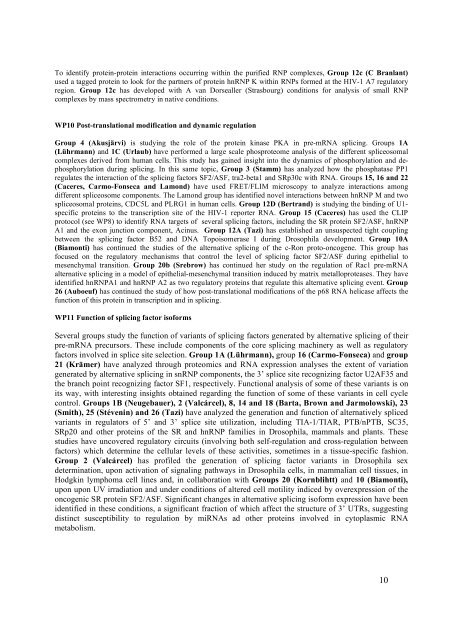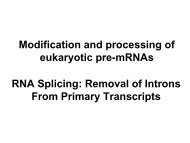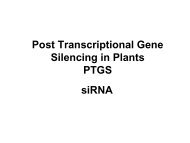Create successful ePaper yourself
Turn your PDF publications into a flip-book with our unique Google optimized e-Paper software.
To identify protein-protein interactions occurring within the purified RNP complexes, Group 12c (C Branlant)used a tagged protein to look for the partners of protein hnRNP K within RNPs formed at the HIV-1 A7 regulatoryregion. Group 12c has developed with A van Dorsealler (Strasbourg) conditions for analysis of small RNPcomplexes by mass spectrometry in native conditions.WP10 Post-translational modification and dynamic regulationGroup 4 (Akusjärvi) is studying the role of the protein kinase PKA in pre-mRNA splicing. Groups 1A(Lührmann) and 1C (Urlaub) have performed a large scale phosproteome analysis of the different spliceosomalcomplexes derived from human cells. This study has gained insight into the dynamics of phosphorylation and dephosphorylationduring splicing. In this same topic, Group 3 (Stamm) has analyzed how the phosphatase PP1regulates the interaction of the splicing factors SF2/ASF, tra2-beta1 and SRp30c with RNA. Groups 15, 16 and 22(Caceres, Carmo-Fonseca and Lamond) have used FRET/FLIM microscopy to analyze interactions amongdifferent spliceosome components. The Lamond group has identified novel interactions between hnRNP M and twospliceosomal proteins, CDC5L and PLRG1 in human cells. Group 12D (Bertrand) is studying the binding of U1-specific proteins to the transcription site of the HIV-1 reporter RNA. Group 15 (Caceres) has used the CLIPprotocol (see WP8) to identify RNA targets of several splicing factors, including the SR protein SF2/ASF, hnRNPA1 and the exon junction component, Acinus. Group 12A (Tazi) has established an unsuspected tight couplingbetween the splicing factor B52 and DNA Topoisomerase I during Drosophila development. Group 10A(Biamonti) has continued the studies of the alternative splicing of the c-Ron proto-oncogene. This group hasfocused on the regulatory mechanisms that control the level of splicing factor SF2/ASF during epithelial tomesenchymal transition. Group 20b (Srebrow) has continued her study on the regulation of Rac1 pre-mRNAalternative splicing in a model of epithelial-mesenchymal transition induced by matrix metalloproteases. They haveidentified hnRNPA1 and hnRNP A2 as two regulatory proteins that regulate this alternative splicing event. Group26 (Auboeuf) has continued the study of how post-translational modifications of the p68 RNA helicase affects thefunction of this protein in transcription and in splicing.WP11 Function of splicing factor isoformsSeveral groups study the function of variants of splicing factors generated by alternative splicing of theirpre-mRNA precursors. These include components of the core splicing machinery as well as regulatoryfactors involved in splice site selection. Group 1A (Lührmann), group 16 (Carmo-Fonseca) and group21 (Krämer) have analyzed through proteomics and RNA expression analyses the extent of variationgenerated by alternative splicing in snRNP components, the 3’ splice site recognizing factor U2AF35 andthe branch point recognizing factor SF1, respectively. Functional analysis of some of these variants is onits way, with interesting insights obtained regarding the function of some of these variants in cell cyclecontrol. Groups 1B (Neugebauer), 2 (Valcárcel), 8, 14 and 18 (Barta, Brown and Jarmolowski), 23(Smith), 25 (Stévenin) and 26 (Tazi) have analyzed the generation and function of alternatively splicedvariants in regulators of 5’ and 3’ splice site utilization, including TIA-1/TIAR, PTB/nPTB, SC35,SRp20 and other proteins of the SR and hnRNP families in Drosophila, mammals and plants. Thesestudies have uncovered regulatory circuits (involving both self-regulation and cross-regulation betweenfactors) which determine the cellular levels of these activities, sometimes in a tissue-specific fashion.Group 2 (Valcárcel) has pro<strong>file</strong>d the generation of splicing factor variants in Drosophila sexdetermination, upon activation of signaling pathways in Drosophila cells, in mammalian cell tissues, inHodgkin lymphoma cell lines and, in collaboration with Groups 20 (Kornblihtt) and 10 (Biamonti),upon upon UV irradiation and under conditions of altered cell motility indiced by overexpression of theoncogenic SR protein SF2/ASF. Significant changes in alternative splicing isoform expression have beenidentified in these conditions, a significant fraction of which affect the structure of 3’ UTRs, suggestingdistinct susceptibility to regulation by miRNAs ad other proteins involved in cytoplasmic RNAmetabolism.10







